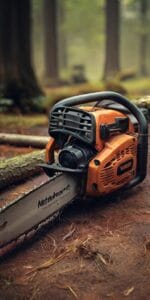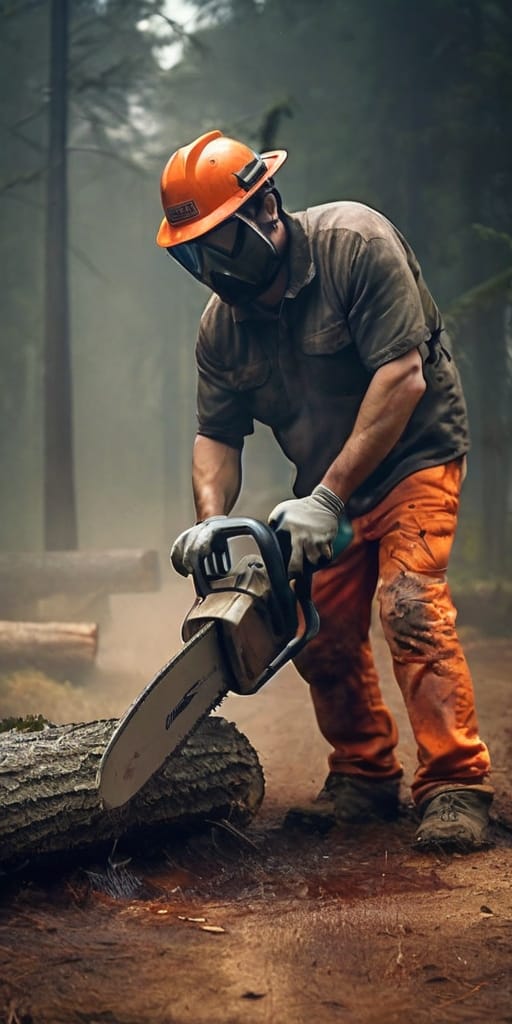Ever wonder why some of your woodworking projects turn out to be frustrating? Why does your chainsaw pull to the left or right? Despite all your efforts, does cutting wood feel like a chore? In this article, as a carpenter, I’ll delve into the root causes of these common problems and share solutions. Let’s discover together how to make your chainsaw cut straight!
Your chainsaw should cut straight, and if it’s pulling left or right, then something is wrong. This is a pretty common problem for chainsaw users, and I’ve seen a wide range of explanations in online forums and discussion boards. Unfortunately, some of the suggestions out there are just plain wrong.

I was talking with my dad today, a forester with over 30 years of experience, and he had adamant reactions to some of the online comments. So, in this post, we’re going to set the record straight.
If your chainsaw is not cutting straight, this is due to one of two things:
- Your chain is dull on one side.
- The edges of your bar are uneven.
There are several ways these two things could happen. Let’s look at each one individually below, then we’ll talk about solving the problem.
Note: If you’re wondering if it could be from a bend or bump on your chainsaw bar, that’s not it. Think about it; you can’t cut a log in a curved moon shape, and if there was a significant bend, it would probably throw the chain. If you’ve got a pull in one direction, it’s one of the two things above.
Now let’s get to the problem-solving!
1. Your Chain is Dull on One Side
This is probably the most common reason your chainsaw could be pulling in one direction. Both new and experienced chainsaw users could encounter this problem.
A. Causes of an Uneven Chain
Imagine this: you’re chunking up a fallen tree, and when you get through the log, you hit a patch of dirt. I’ve done it; it happens.
When you hit dirt or grind into a rock, that can take a big toll on your chain.
I know what you’re thinking, “Duh!” If you hit a rock with your chain, it’s going to damage it. Pretty obvious.
But what you might not have thought about is the fact that hitting a rock will wear down one side of your chain more than the other side. Think about it; one side will be taking the bulk of the damage.
As a result, if you’re trying to figure out why your chainsaw won’t cut straight, ask yourself if you’ve recently ground into something. If you have, then your problem is almost definitely a chain that is duller on one side.
There’s another reason you might have an uneven chain, and that’s lopsided sharpening. If you’re inexperienced and have been sharpening your chain with a manual file, then it’s possible that you’ve ground one side harder than the other. The result is a “crooked” cut.
So to summarize, if you have an uneven chain, then it was probably caused by:
- Hitting dirt, a rock, etc.
- Sharpening your chain unevenly
If you don’t think either of these are your problem, then skip down to section 2 below. Otherwise, let’s dive into fixing the chain.
B. How to Fix an Uneven Chain
If it’s a minor case, then you might be able to fix it by sharpening the chain with a file until it’s even.
Your chain will have links on both sides of the chain. Each guide link AND each cutter link will have a small line on it. See the image below for an example of what this line looks like. Want to learn more about chain anatomy? Check out this article.
The purpose of these lines is to show the point at which a link can no longer be sharpened (e.g., the maximum amount of metal that can be removed).
For our purposes here, the line is also helpful as a comparison tool. It provides a consistent benchmark that you can use to compare how far links on each side are ground down.
If there are huge differences, then you may want to have your chain professionally sharpened at a local saw shop. If there are chips or breaks in the chain, then it will need to be replaced.

How to Prevent an Uneven Chain
Once your chain is fixed, sharpened, or replaced, you’ll want to maintain it properly. The best way to do this is by avoiding the causes of chain damage mentioned earlier.
In other words, be extra cautious not to hit dirt or rocks with your chain. While it can still happen occasionally, we can all be a bit more careful. If you’re cutting wood on the ground, try to stop about six inches above the ground and then roll the log over to finish the cut from the other side. If moving the log isn’t feasible, keep your chainsaw level with the ground to minimize contact with dirt.
Another issue we’ve discussed is uneven sharpening. To prevent this, use a file with a guide. A guide helps ensure even sharpening on both sides. Additionally, practice applying equal pressure when sharpening from each end. This is a skill that can take some time to perfect.
2. The Edges of Your Bar Are Uneven
While the chain is usually the primary culprit, if that’s not the issue, your chainsaw bar might be the problem.
A. Causes of an Uneven Bar
It’s almost inevitable for the edges of a chainsaw bar to wear unevenly over time. The metal-to-metal friction between the bar and the chain will gradually wear away the material. The side that loses material more quickly can depend on your dominant hand, the direction a tree is leaning, and other factors.
A best practice among experienced chainsaw users is to regularly flip the bar to even out the wear. If you’re not doing this, one edge of your bar will likely get shorter than the other, leading to uneven cuts.
B. How to Fix an Uneven Bar
You can fix an uneven bar by filing the edges until they are level. Here’s how:
- Use a file to scrape the edges of your bar while holding it as evenly as possible.
- Do this every time you perform maintenance on your chainsaw.
A specific tool like the Pferd edge sharpener can help make this task easier. Using a filing tool is better for your bar and more cost-effective than having someone grind the edge at a saw shop.
C. How to Prevent an Uneven Bar
A good rule of thumb is to flip your chainsaw bar every time you refill the fuel. Here’s how to do it on most chainsaws:
- Remove the front panel.
- Lift the bar off the chainsaw.
- Remove the chain.
- Flip the bar over and reassemble everything.
Bonus: Keeping Your Chainsaw Bar Clean
The chainsaw bar groove accumulates oil, sawdust, and dirt. It runs better without all that debris. Use a gauge tool to slide along the bar groove and clean it out.
Also, clean the oil hole on both sides of the bar to ensure smooth operation. This can prevent smoking and overheating, extending the life of your chainsaw.

